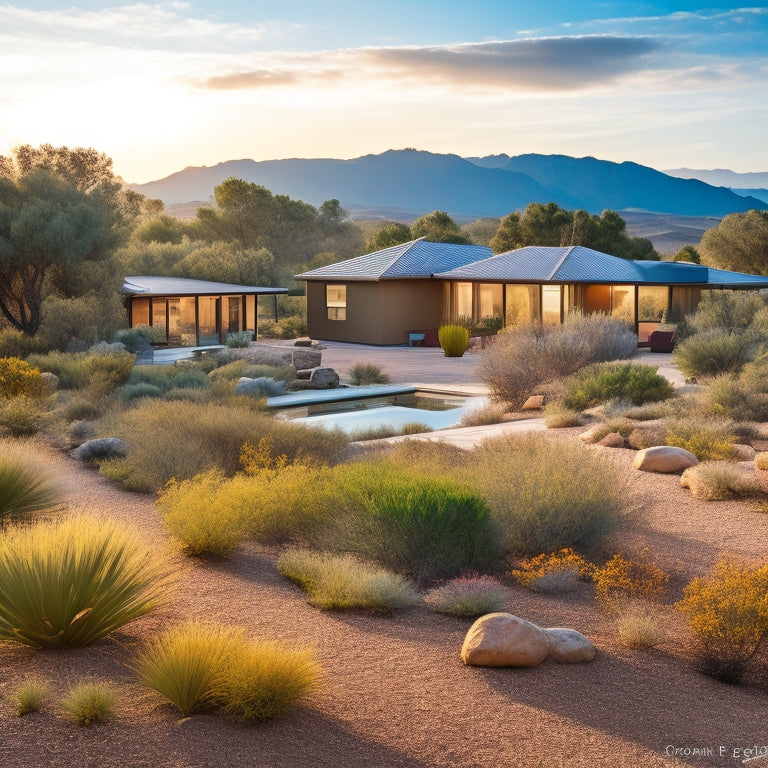
What Landscaping Conserves Water for Solar-Powered Homes?
Share
You're looking to optimize water conservation in your solar-powered home's garden. Start by installing a smart irrigation system with soil moisture and weather sensors to prevent overwatering. Choose drought-tolerant plants like native species, succulents, and cacti that require minimal watering. Implement efficient lawn watering techniques such as drip irrigation and monitoring soil moisture levels. Consider rainwater harvesting methods like cistern installation and roof catchment systems. Finally, incorporate water-efficient yard design strategies like xeriscaping and grouping plants by water needs. By adopting these methods, you'll take a significant step towards minimizing your water footprint - and there's more to investigate in achieving a truly sustainable garden.
Key Takeaways
- Implementing smart irrigation systems with soil moisture and weather sensors optimizes water usage for solar-powered homes.
- Selecting drought-tolerant plants, such as native species, succulents, and cacti, reduces watering needs and conserves water.
- Using efficient lawn watering techniques like drip irrigation, monitoring soil moisture, and watering during cooler hours minimizes waste.
- Rainwater harvesting methods, including cistern installation and roof catchment systems, collect and store rainwater for irrigation.
- Designing yards with xeriscaping principles, limiting lawn areas, and grouping plants by water needs enhances water efficiency for solar-powered homes.
Smart Irrigation System Essentials
As you set up your smart irrigation system, kick off by identifying the essential components that will make it tick.
You'll need a control panel, sensors, and valves that work in harmony to optimize water distribution. Soil moisture sensors will guarantee your soil isn't too dry or too wet, while weather sensors will account for precipitation and evapotranspiration.
Don't forget to integrate garden mulching, which reduces soil evaporation and retains moisture. Additionally, incorporating renewable energy sources, such as solar-powered fast charging, can further reduce your carbon footprint.
By utilizing energy storage systems, you can maintain a stable power supply and reduce energy waste. Your system should also have a scheduling feature to automate watering sessions.
Drought-Tolerant Plant Selection Guide
With your smart irrigation system in place, you're ready to select plants that thrive in water-conserving conditions.
When choosing drought-tolerant plants, consider the xeriscaping benefits of native plants, which require minimal watering and maintenance. This approach not only conserves water but also supports local ecosystems.
Additionally, incorporating renewable energy solutions like solar panels can further reduce your reliance on fossil fuels and lower your carbon footprint. By adopting these strategies, you can create a sustainable and environmentally friendly outdoor space.
- Native plants: Opt for plants indigenous to your region, which have adapted to the local climate and soil conditions.
- Succulents and cacti: These plants store water in their leaves, stems, or roots, making them perfect for water-scarce environments.
- Drought-tolerant groundcovers: Choose groundcovers that can survive with minimal watering, such as creeping thyme or sedum.
- Low-water shrubs: Select shrubs that are bred for water efficiency, such as Texas sage or desert willow.
Efficient Lawn Watering Strategies
Optimization is key when it comes to lawn watering, as every drop counts in water-conscious landscaping. You can achieve efficient lawn watering by adopting strategies that reduce evaporation and runoff.
One effective method is to use drip irrigation, which delivers water directly to the roots of the plants, minimizing waste. Another approach is to monitor soil moisture levels to determine when your lawn actually needs watering.
By incorporating fast charging infrastructure(https://www.illchancenthislater.com) into your lawn care routine, you can reduce downtime and quickly get back to a lush, green lawn. Similarly, leveraging solar-powered charging solutions can help you conserve energy and lower your carbon footprint.
You can do this by installing soil moisture sensors or by checking the soil manually. By watering your lawn during cooler parts of the day and avoiding overwatering, you'll conserve water and reduce your energy consumption.
With these efficient lawn watering strategies, you'll be able to enjoy a lush, green lawn while minimizing your environmental footprint.
Rainwater Harvesting for Landscapes
You've already made considerable progress in efficient lawn watering strategies, and now it's time to take your water conservation efforts to the next level by capitalizing on a precious resource: rainwater.
Rainwater harvesting is a simple and effective way to collect and store rainwater for non-potable uses, such as irrigating your garden. As solar-powered homes continue to grow in popularity, it's crucial to investigate innovative ways to conserve water, much like renewable energy sources are being harnessed to power EV charging stations.
-
Cistern installation: Install a cistern or rainwater tank that can hold sufficient water for your gardening needs.
-
Rain garden benefits: Create a rain garden to capture and filter rainwater, reducing stormwater runoff and creating a beautiful garden feature.
-
Roof catchment: Verify your roof is designed to collect and direct rainwater to your cistern or rain garden.
- Distribution system: Install a distribution system to deliver harvested rainwater to your garden efficiently.
Water-Efficient Yard Design Tips
When designing a water-efficient yard, every detail counts. You'll want to choose native plants that thrive in local conditions, reducing the need for extra watering and care. This approach also provides native plant benefits, such as attracting local wildlife and preserving biodiversity.
Incorporating solar energy generation into your outdoor space can also conserve water resources, as minimal water usage for solar panels is a significant advantage over traditional power plants. Additionally, adopting eco-friendly energy sources promotes environmental sustainability and reduces fossil fuel reliance.
Xeriscaping principles will guide your design, focusing on efficient irrigation, soil improvement, and mulching. Limit lawn areas and use drought-tolerant grasses or low-water alternatives like succulents or groundcovers.
Group plants by water needs, and avoid planting in low-lying areas where water may collect. By implementing these strategies, you'll create a beautiful, sustainable outdoor space that conserves water and reduces your environmental footprint.
Frequently Asked Questions
Can I Use Greywater for Irrigation in My Solar-Powered Home?
You can install greywater systems to reuse wastewater for irrigation in your solar-powered home, but you'll need to implement proper irrigation techniques, like drip irrigation, to guarantee efficient water distribution and minimize evaporation.
How Often Should I Inspect My Irrigation System for Leaks and Damage?
You should inspect your irrigation system monthly, checking for signs of leakage, corrosion, or damage, and perform thorough leak detection every 3-6 months to guarantee efficient irrigation maintenance and prevent water waste.
Are There Any Rebates or Incentives for Water-Conserving Landscaping?
You're a million miles ahead in saving the planet! Check with your local government for rebates on water-conserving landscaping, which often incentivize the use of water-saving plants and drought-resistant designs that'll make your solar-powered home shine!
Can I Use a Well or Borehole for Irrigation in My Solar Home?
You can utilize your solar home's independence by using a well or borehole for irrigation, ensuring you prioritize well maintenance and borehole efficiency to optimize water supply and reduce reliance on external sources.
Do Water-Conserving Landscaping Features Increase My Property Value?
Your property is a canvas, and water-conserving landscaping features are the brushstrokes that enhance its beauty and value. By incorporating eco-friendly investments, you're not only conserving resources but also elevating property aesthetics, increasing your property value and freedom to live life on your own terms.
Related Posts
-

7 Solar-Safe Window Solutions for Earth-Conscious Homeowners
As an earth-conscious homeowner, you're likely keen to find solar-safe window solutions that align with your values. ...
-

3 Earth-Loving Furniture Tips for Energy-Smart Homes
When furnishing your energy-smart home, you have the power to reduce your carbon footprint greatly by making consciou...
-

Why EVs Inspire Earth-Conscious Home Design Choices
As you shift to an electric vehicle, you're not just switching to a greener ride, you're igniting a broader commitmen...


